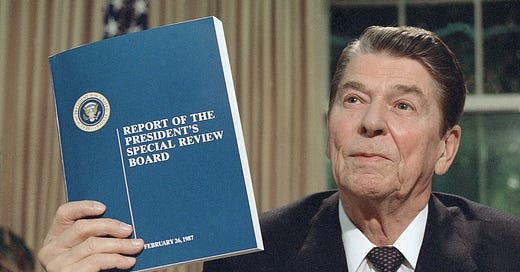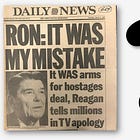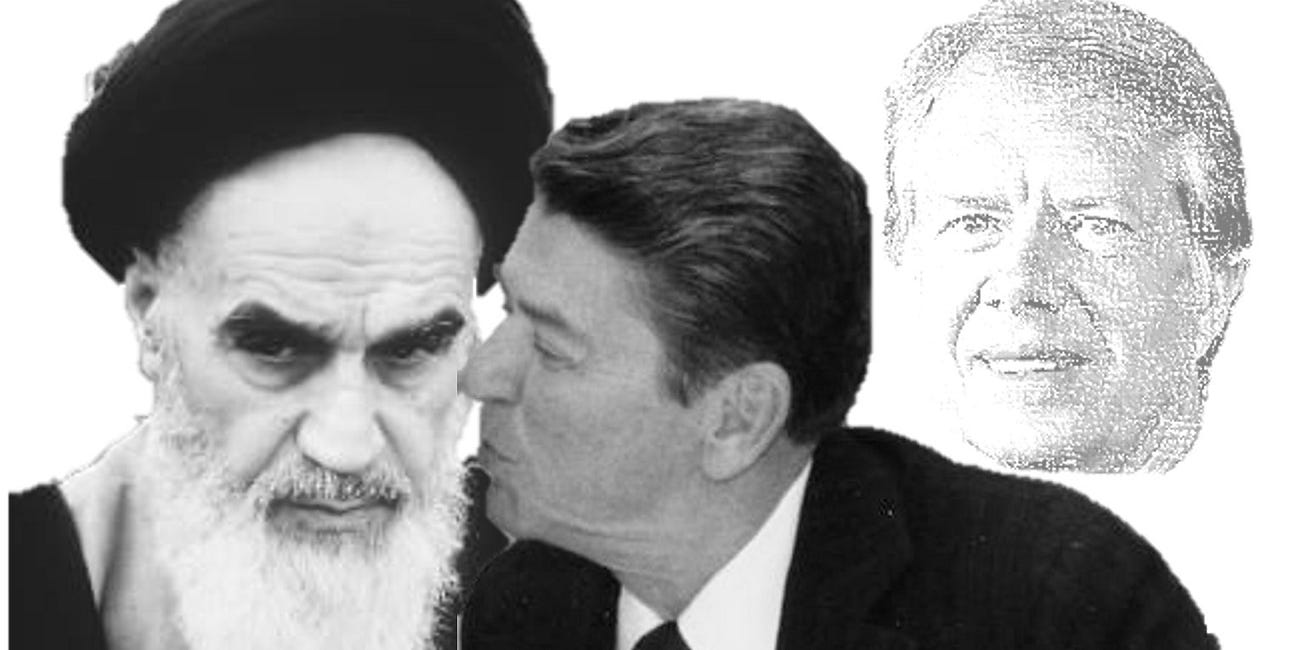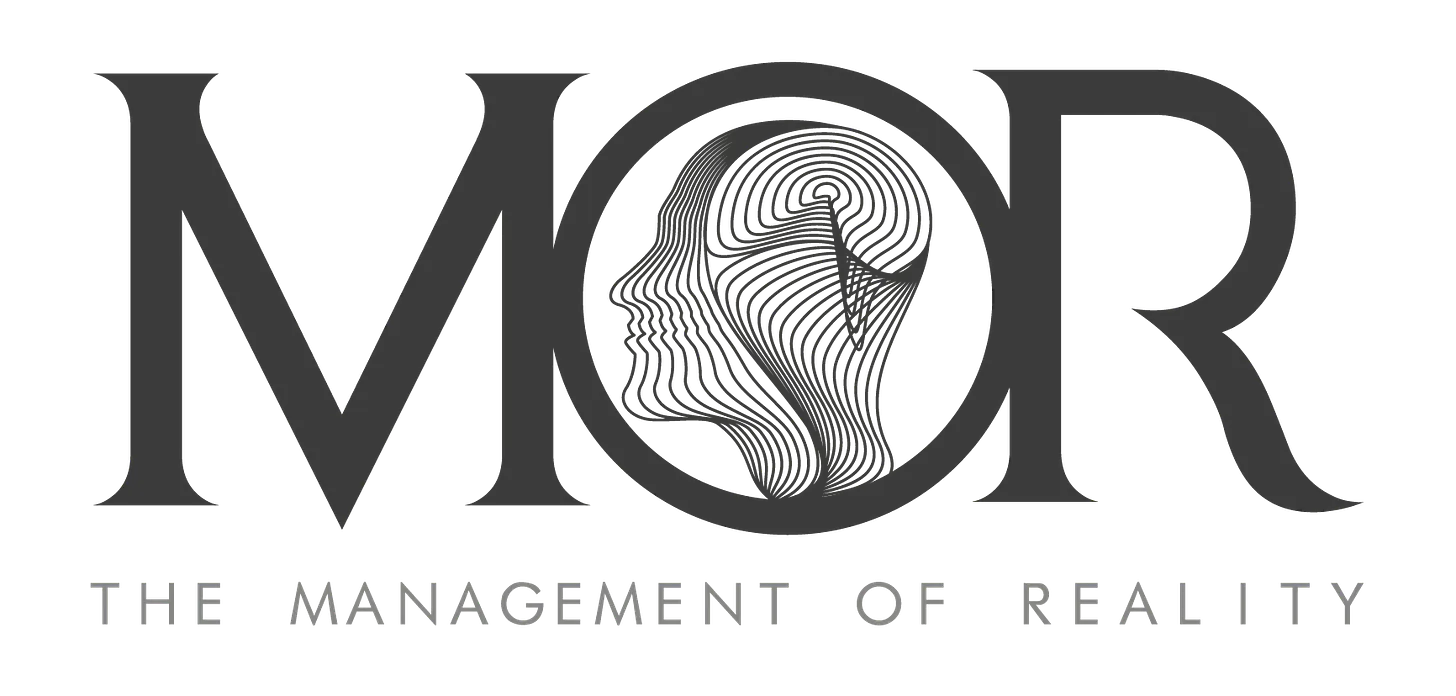IRAN-CONTRA: STILL A MYSTERY. Part 4: Did US Intelligence control media and academia?
Iran-Contra's untold story...
If you didn’t read Part 3 yet, you may do so here:Congressional Iran-Contra investigators in the 1980s found that Reagan-Bush had corrupted the entire Extended Fourth Estate (media plus academia)—and beyond.
But senators and representatives in the US Congress blocked inclusion of that chapter in the official congressional report.
The clandestine CIA control of the Fourth Estate was never fixed.
This piece is the fourth in my series on Iran-Contra.
As a political and geopolitical event, and in terms of diagnosing the system, how important was the Iran-Contra Scandal or Affair? Think of Iran-Contra as the Sun.
You wouldn’t try to explain the structure of the solar system without the Sun, would you? You can’t. The Sun pulls everything around itself because it is the biggest and heaviest thing in the solar system. That’s why we call it the solar system (sol = sun).
Iran-Contra was the biggest, most important, most diagnostic event in the entire post-WWII history of US foreign policy. So, if you haven’t explained Iran-Contra, you don’t know jack.
At a descriptive level, what was Iran-Contra?
In the early 1980s, a US-government cabal lead by President Ronald Reagan and Vice-President George Bush Sr. conspired in secret with top bureaucrats to send billions of dollars in armament to the jihadi/terrorist Iranian regime of Ayatollah Ruhollah Khomeini (see Part 1).
That’s the regime that still rules Iran, and which, since its founding in 1979, has been publicly pledged to the destruction of the United States (yes, they also want to destroy Israel, but what matters for this presentation is that they are terrorist enemies of the United States).
Young people today have heard of the famous Watergate Scandal—a nothing burglary; yet few can tell you what the Iran-Contra Affair was about, or even recognize the name of that scandal. Why? Because the Extended Fourth Estate (media plus academia) hardly ever mentions it.
That’s remarkable because, under US law, dramatically aiding and abetting a mortal, terrorist enemy of the United States and all its citizens, and especially if done by the Commander in Chief of all US Armed Forces, constitutes a clear case of treason. And treason seems like the sort of thing that US citizens should remember (lest they be condemned to repeat it).
But something seems to have gone wrong—because they don’t remember.
Until recently I was a college professor, and, in my experience, even most college students who study political science and international relations have a dim understanding of what happened even at a bare-bones descriptive level (I have asked them). And that’s when Iran-Contra registers at all, which, for many, it just doesn’t.
Of course, people would remember Ronald Reagan and George Bush getting tried for treason (for which the fitting punishment under US law is execution). But that never happened. To the contrary: George Bush became the next president.
How did Reagan-Bush get away with that?
When caught red-handed sending secret weapons to the Iranian jihadi terrorists, in 1986, Reagan-Bush excused their criminal behavior by claiming these were well-intentioned ransom payments to free Hezbollah-held US hostages in Lebanon. The ‘logic’ of that went like this: since the Lebanese terrorist group Hezbollah was spawned by the Iranian Revolutionary Guard Corps (IRGC), Reagan-Bush had sent billions in weapons to Khomeini in order to beg him for his influence on Hezbollah to free that handful of hostages.
The congressional investigators and the media all cooperated with this narrative while Reagan-Bush were still in office, even though the proffered excuse was, on its face, perfectly absurd. So Reagan-Bush got away with it. And when Bush became president in 1989 he pardoned anybody still being prosecuted for Iran-Contra crimes.
As you might expect, the evidence has soundly refuted the Reagan-Bush narrative.
To begin with, for every hostage freed during the time of those weapons transfers, new hostages were taken by Hezbollah, yet the weapons transfers continued (see below).
More decisively: several investigations demonstrated that the weapons transfers to Iran had begun in 1981, whereas the first Hezbollah hostage was taken in 1982, so the decision to begin sending lots of weapons to jihadi Iran obviously had absolutely nothing to do with hostages in Lebanon that didn’t yet exist (see Part 2).
That point was emphasized by legendary journalist Seymour Hersh in a piece that summarized those investigations on page one of the New York Times, in 1991 (see Part 2). On the real reasons behind the weapons transfers, however, Hersh punted: “No American rationale for permitting covert arms sales to Iran could be established.”
So, on the causes of the biggest scandal imaginable, the biggest scandal ever, the most important newspaper in the world, ‘the newspaper of record,’ said: we’ve got nothing.
Then, almost immediately, as if the Reagan-Bush narrative had not been refuted already in 1991 by Seymour Hersh on page one of the New York Times, the entire Extended Fourth Estate—including the NYT and Seymour Hersh!—began ‘remembering’ the Iran-Contra Affair for US citizens in a manner exactly matching Reagan-Bush’s self-serving ‘arms for hostages’ propaganda (see Part 3).
That sort of thing makes a body wonder about clandestine control of media and academia.
And the Fourth Estate has also been cooperating, in it’s ‘recollection’ of Iran-Contra, with the Reagan-Bush gambit to focus everybody’s attention on a meaningless detail: a minuscule diversion of funds from Iranian weapons sales to the Nicaraguan Contras. It is astonishing to watch academics and journalists write now as if this nothing detail—designed to distract us from the magnitude of Reagan-Bush’s treason—meant anything (see Part 3). History has been rewritten.
This again makes a body wonder.
But there is scant need to wonder, in fact. The Iran-Contra congressional inquiries produced an investigation into the relationship of government and the media. What they found, as the authors described it, was an “Orwellian” structure: media control so complete it reeked of totalitarianism.
Most US citizens never learned of this. How to interpret that? It’s an important question. We will consider it here.
The congressional Iran-Contra report
In the wake of the Iran-Contra revelations, the US Congress conducted official investigations that were collected in an official report. This report rails against the Reagan administration in what, to an innocent, might seem like strong language. The Iran-Contra Affair, the report accuses, amounts to
“a credibility crisis that raised serious questions about the adherence of the [Reagan-Bush] Administration to the Constitutional process of Government … [with] such serious implications for US foreign policy, and for the rule of law in a democracy, that the 100th Congress determined to undertake its own investigation of the Affair.”1
Tough words?
But look closer. This report in fact handed Reagan-Bush their most important propaganda victory, for it accepted that “The United States,” as it stated, “had sold arms to Iran and had hoped thereby to gain the release of American hostages in Lebanon.”2
Now, I will concede that in November 1987, when this congressional report saw the light of day, Seymour Hersh had yet to publish ‘The Iran Pipeline’ in the New York Times. That would not come until 1991. In principle, then, one may argue that the congressional investigators didn’t yet have, in 1987, a definitive refutation of the Reagan-Bush ‘arms for hostages’ claim. And while that is true, it still doesn’t change the fact that the ‘arms for hostages’ excuse was always preposterous, and more so in light of what the second paragraph of the preface to this same Iran-Contra report itself states:
“even though the Iranians received the arms, just as many Americans remained hostage [in Lebanon] as before. Three had been freed, but three more had been taken hostage during the period of the [weapons] sales.”3
These facts—already officially in evidence in 1987—were perfectly inconsistent with the claim that Reagan-Bush’s weapons sales to Iran were in exchange for freeing the hostages. One is therefore compelled to ask: Why did the congressional investigators accept the Reagan-Bush propaganda claim? Were they, under all that oppositional bluster, in fact giving Reagan-Bush some needed cover?
Yes, that is exactly what Congress was doing, according to a paper titled ‘Iran-Contra’s Untold Story.’
That paper was published—just a few months after the congressional Iran-Contra report was released—in the important academic journal Foreign Policy, and it was authored by two leading Iran-Contra investigators: Robert Parry and Peter Kornbluh. Parry & Kornbluh claimed that the entire system, from Congress to the major media, had been corrupted by US Intelligence.
Iran-Contra’s Untold Story
The Parry & Kornbluh paper shared that an entire draft chapter was missing from the published Iran-Contra congressional report. That draft chapter described a “public diplomacy apparatus” created by the Reagan-Bush administration to influence domestic public opinion via control of the media. The official name of this thing was ‘State Department’s Office of Public Diplomacy for Latin America,’ but that name was a cover: it wasn’t Latin America they sought to influence but the American public.
This organ was known internally by its initials S/LPD (I guess the ‘S’ is for ‘State Department,’ the ‘L’ for Latin America, and ‘PD’ would be ‘Public Diplomacy’). It was CIA Director William Casey and “the CIA’s leading propaganda expert,” Walter Raymond Jr., who had created the S/LPD for Reagan, housing it within the State Department.
But the public was not told about all this, even after the Iran-Contra investigations concluded, because the draft chapter documenting this crime against US media institutions was left “on the cutting room floor”—it was not included in the Iran-Contra congressional report. And why not? Because its inclusion was “blocked by House and Senate Republicans.”4
“Kept from the public domain, therefore, was the draft chapter’s explosive conclusion: that, according to one congressional investigator, senior CIA covert operatives were assigned to the White House to establish and manage a covert domestic operation designed to manipulate the Congress and the American public. … Reagan created what appears to be America’s first peacetime propaganda ministry.”5
Reagan-Bush had created
“a sophisticated apparatus … [that] mixed propaganda with intimidation … [with] Orwellian methods … [that] could be one of the most troubling legacies of Reagan’s presidency. … [A] set of domestic political operations comparable to what the CIA conducts against hostile forces abroad. … [A] public diplomacy apparatus … ‘to manipulate [US] opinion’ … [that one] public diplomacy official termed … a ‘vast psychological warfare operation’ … [that] pressured journalists and news executives into compliance.” (my emphasis)6
Reading Parry & Kornbluh—for example, upon reading the phrase “first peacetime propaganda ministry”—one might get the impression that, historically, peacetime clandestine control over the media surfaced for the first time during the Reagan-Bush administration. But that is false.
Just a few years before this, in the period 1967-1976, there had already been an extended scandal concerning massive CIA intervention of the media, which rather loudly screams that Reagan-Bush’s S/LDP was nothing new under the sun. Strangely, Parry & Kornbluh say not a word about that earlier scandal, a mere decade old. (And they could have mentioned earlier interventions, for clandestine control of the press in the United States is an old problem.)
Parry & Kornbluh also write that “Congress quietly shut down the S/LPD.” One might get the impression, from this, that intelligence control over the media was ended then and there and that the Fourth Estate was suddenly restored to independence. Sadly, there are zero grounds to suppose that. As the authors wrote:
“a senior public diplomacy official noted wryly at the time, ‘they can shut down the public diplomacy office, but they can’t shut down public diplomacy.’ ”7
Right, because to shut down that massive program to control the media (and academia) you’d need to shut down the CIA (and they didn’t).
Consider that Reagan-Bush’s ringleader was Walter Raymond from the CIA, who set up the S/LDP in 1982 while still at the CIA. True, Raymond retired from the CIA in 1983, but the obvious interpretation is that he resigned so as to make his continued running of the S/LDP technically ‘not a CIA thing.’ And that technicality was bureaucratically and legally beautiful. If ever discovered, since the S/LDP had been conveniently housed in the State Department, it could be shed like the lizard’s tail of a larger domestic psychological-warfare infrastructure that could continue to operate undisturbed from the CIA.
But for anyone still tempted to imagine that, post-Reagan, a free news market was restored, take just two seconds to reason through what any such restoration would have required.
For starters, there should have been a big stink in Congress about this CIA behavior, followed by fresh investigations, supported by public outrage that would demand new laws—with teeth—to provide for much better congressional oversight over CIA activities that would protect the news from such corruption in the future.
People should have lost their jobs—not only at the CIA, but also among the top executives and journalists in the news media who’d been involved in this. And there should have been prosecutions, plenty of them. First, because the CIA is barred by the National Security Act (1947) from operating clandestine operations to corrupt institutions on US soil (doing it to other countries is entirely legal, and protected by the same law). And second, because 36 States of the Union have laws against commercial bribery, which make press employees on the receiving end of CIA corruption liable for criminal charges.
But none of this was done.
Even all of that, mind you, might not have been enough. A reasonable argument can be made that only by abolishing the State’s right to act in secret and demanding a full and transparent accounting of all State activities, to the last penny (no exceptions allowed), can a free press be reasonably protected.
But even coming short of that, not one detail of the institutional-repair program I outlined above was even halfheartedly attempted.
The absolutely minimal, weakest response to the problem of media and academic corruption would have been to include—instead of censoring—the chapter detailing (some) of the CIA’s activities to corrupt the press in the congressional Iran-Contra report. But even this little bit was not done.
Moreover, George Bush Sr., a former director of the CIA, and the guy conspiring in the White House with Ronald Reagan to create this “peacetime propaganda ministry,” remained in the White House. And he became the next president.
The government did not protect the press; it protected the CIA.
The CIA was warmly cocooned from scrutiny by a widespread congressional, government, and media coverup (itself evidence of ongoing control). So what, pray tell, compelled the CIA to dismantle its already functioning “peacetime propaganda ministry”? Nothing. Nobody learned of it, so nobody was calling for dismantling it.
And the recent behavior of the press, examined in Part 3, certainly furnishes no reason to suppose that any such dismantling ever occurred.
As we saw in Part 3, the most important evidence needed to interpret Iran-Contra was simply erased in the retelling, creating for US citizens a false memory of events that restored to consciousness, as ‘fact,’ the Reagan-Bush ‘arms for hostages’ propaganda.
The same thing was done with Parry & Kornbluh’s piece on Reagan-Bush’s media control: ‘Iran-Contra’s Untold Story’ remains largely untold. Nowhere did the Parry & Kornbluh become frontpage news. Or back page news. (Or middle.) In the years since, according to Google Scholar, the Parry & Kornbluh has averaged just one scholarly mention per year, a figure that, mind you, counts college theses, master’s theses, and unpublished working papers (about half the total).
This is not what happens in a free market. A restored free-and-competitive news market would have been all over the Parry & Kornbluh, and a restored free-and-competitive social-science market would have done the same.
And how far did CIA corruption reach? Was it limited to the Extended Fourth Estate? No, in fact.
The Orwellian structure uncovered by the congressional investigations, as Parry & Kornbluh explained, involved funneling secret monies to all sorts of private outfits, existing and newly created, that posed as civil society organizations and lobbied publicly for the policy positions that the Reagan-Bush effort required.
But more serious, perhaps, is the indirect evidence of corruption in Congress.
Parry & Kornbluh blame “House and Senate Republicans” for the exclusion of the media-corruption chapter from the congressional report, but we can spread the blame to the House and Senate Democrats. For House and Senate Democrats had the power to convene a live press conference to denounce the suppression of the inflammatory draft chapter from the Iran-Contra report.
“Well,” you might object, “but if the press is corrupted, who is going to report the press conference?” But that’s the thing about a live press conference: if it is transmitted live, and the media doesn’t know what the representatives and senators all together are going to say, they’re stuck. And C-SPAN is forced to televise everything that happens in Congress, anyway. So the House and Senate Democrats really could do something.
Indeed, they could have mobilized an official Act of Congress. An Act of Congress might have brought public pressure over to their side, giving them leverage to force the dramatic investigations and legal reforms needed to clean up the press and protect it in the future.
But no such Act of Congress was even attempted. Indeed, Parry & Kornbluh report no effort by House and Senate Democrats to resist or expose the ‘Republican’ cover-up.
And that is rather amazing. At least if you believe that the Democrats compete with the Republicans and care about winning elections. Because they lost the next election to George Bush Sr., top Iran-Contra conspirator.
One is forced to wonder, then: How big was the pro-jihadi conspiracy?
We will address that question next.
Inouye, Daniel K., Hamilton Lee H. (1987). Report of the congressional committees investigating the Iran- Contra Affair : with supplemental, minority, and additional views. Senate Report #216. Washington : U.S. House of Representatives Select Committee to Investigate Covert Arms Transactions with Iran : U.S. Senate Select Committee on Secret Military Assistance to Iran and the Nicaraguan Opposition. (p.7)
https://archive.org/stream/reportofcongress87unit#page/n21/mode/2up
Ibid. (p.7)
Ibid. (p.xv)
Parry, R., & Kornbluh, P. (1988). Iran- Contra's Untold Story. Foreign Policy, 72, 3-30 (pp.3, 28)
https://www.jstor.org/stable/1148818
Parry, R., & Kornbluh, P. (1988). Iran-Contra's Untold Story. Foreign Policy, 72, 3-30. (pp.3,5)
https://www.jstor.org/stable/1148818
Parry, R., & Kornbluh, P. (1988). Iran-Contra's Untold Story. Foreign Policy, 72, 3-30. (pp.3-5)
https://www.jstor.org/stable/1148818
Parry, R., & Kornbluh, P. (1988). Iran-Contra's Untold Story. Foreign Policy, 72, 3-30. (pp.4, 9, 16, 28)
https://www.jstor.org/stable/1148818









There is a video of a Saudi commenter doing the rounds. In it, he says that the Saudis funded Contras in exchange for a Palestinian state. Arafat never came to the table.